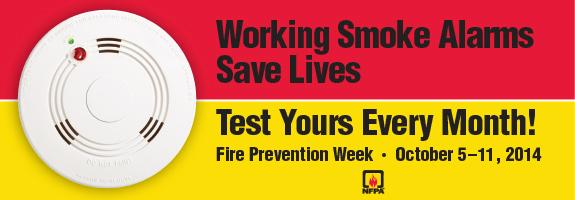| Welcome to Fire Prevention Week 2014! This year's theme is "Working Smoke Alarms Save Lives".
Fire Prevention Week was established to commemorate the Great Chicago Fire, the tragic 1871 conflagration that killed more than 250 people, left 100,000 homeless, destroyed more than 17,400 structures and burned more than 2,000 acres. The fire began on October 8, but continued into and did most of its damage on October 9, 1871.
Every year the National Fire Protection Association has a theme for the week to emphasize ways we can all prevent fires. This year's theme involves smoke alarms and the need to ensure they are functioning properly on a regular basis. The Malvern Fire Company urges you to check your detectors every month.
If you need help checking your detectors, or you need help installing a detector, please call the fire station at 610-647-0693 and we will be glad to help!
Here are some facts from the NFPA:
Home fires
•In 2011, U.S. fire departments responded to 370,000 home structure fires. These fires caused 13,910 civilian injuries, 2,520 civilian deaths, $6.9 billion in direct damage.
•On average, seven people died in U.S. home fires per day from 2007 to 2011.
•Cooking is the leading cause home fires and home fire injuries, followed heating equipment.
•Smoking is a leading cause of civilian home fire deaths.
•Most fatal fires kill one or two people. In 2012, 8 home fires killed five or more people resulting in a total of 44 deaths.
Smoke alarms
•Almost three of five (60%) of reported home fire deaths in 2007 to 2011 resulted from fires in homes with no smoke alarms or no working smoke alarms.
•Working smoke alarms cut the risk of dying in reported home fires in half.
•In fires considered large enough to activate the smoke alarm, hardwired alarms operated 93% of the time, while battery powered alarms operated only 79% of the time.
•When smoke alarms fail to operate, it is usually because batteries are missing, disconnected, or dead.
•An ionization smoke alarm is generally more responsive to flaming fires and a photoelectric smoke alarm is generally more responsive to smoldering fires. For the best protection, or where extra time is needed, to awaken or assist others, both types of alarms, or combination ionization and photoelectric alarms are recommended. |

